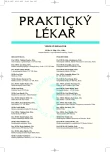-
Medical journals
- Career
Microangiopathic haemolytic anemia (MAHA) as a main symptom of a generalized tumour
Authors: J. Procházková 1; A. Hluší 1; D. Kurfúrstová 2; K. Indrák 1
Authors‘ workplace: Hemato-onkologická klinika FN a LF UP, Olomouc Přednosta: Prof. MUDr. Karel Indrák, DrSc. 1; Ústav patologie FN a LF UP, Olomouc Přednosta: doc. MUDr. Martin Tichý, CSc. 2
Published in: Prakt. Lék. 2007; 87(11): 673-675
Category: Case Report
Overview
Microangiopathic haemolytic anemia (MAHA) is an uncommon - although not rare - condition, which accompanies a number of diseases with a heterogeneous aetiology, including malignant tumours. MAHA may be the first sign of an as yet hidden malignant disease. The exact pathogenesis of cancer–associated MAHA is not yet fully understood. Subjective complaints and objective clinical findings are very diverse but non-specific. For this reason, laboratory tests are the key to establishing a correct diagnosis; findings exhibit a varied level of haemolytic anemia with an increase in reticulocytes, moderate to severe thrombocytopenia, signs of intravascular haemolysis and schistocytes in peripheral blood smears. Due to the fact that MAHA syndrome is usually present in late or terminal stages of malignancies, the prognosis is extremely unfavourable and most patients die within several weeks. Only early tumour diagnosis and the prompt introduction of antitumour therapy in combination with intensive supportive therapy may offer hope of success.
Key words:
microangiopathic haemolytic anemia, adenocarcinoma, schistocyte.
Labels
General practitioner for children and adolescents General practitioner for adults
Article was published inGeneral Practitioner

2007 Issue 11-
All articles in this issue
- Robot-assisted techniques in cardiology
- Fibromyalgia
- Quality of life improvement in patients with bone metastases treated by clodronate
- New options in surgical treatment
- The occurrence of heterozygous mutations in the HFE gene in chronic liver diseases
- Mesodiencephalic modulation to ease the symptoms of diabetic neuropathy – a cross-over study
- Remarks to the problems of drug-induced photosensivite reactions
- Myxoma of the left atrium
- Microangiopathic haemolytic anemia (MAHA) as a main symptom of a generalized tumour
- Acute liver failure due to disulfiram – a case study
- Squamous cell carcinoma in venous stasis ulcer
- Urinary prolyl-hydroxyproline dipeptide as a useful osteomarker easily determined in non-hydrolyzed urine.
- General Practitioner
- Journal archive
- Current issue
- Online only
- About the journal
Most read in this issue- Microangiopathic haemolytic anemia (MAHA) as a main symptom of a generalized tumour
- Acute liver failure due to disulfiram – a case study
- Fibromyalgia
- Mesodiencephalic modulation to ease the symptoms of diabetic neuropathy – a cross-over study
Login#ADS_BOTTOM_SCRIPTS#Forgotten passwordEnter the email address that you registered with. We will send you instructions on how to set a new password.
- Career

